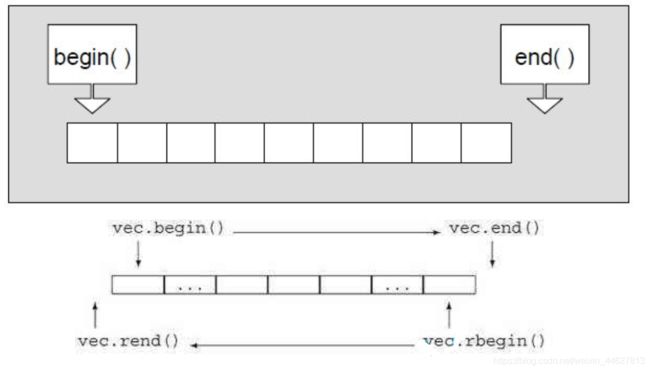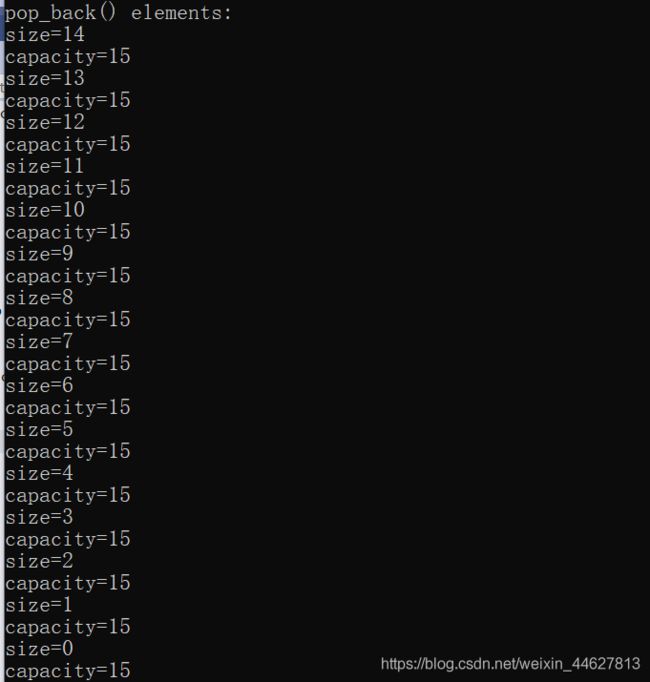STL--vector容器介绍和使用以及迭代器失效问题
一、vector的介绍
1、vector是表示可变大小的序列容器。
2、就像数组一样,vector也采用的连续存储空间来存储元素。也就意味着可以采用下标对vector的元素进行访问和数组一样高效。但是又不像数组,它的大小可以动态改变的,而且它的大小会被容器自动处理。
3、本质讲,vector使用动态分配数组来存储它的元素。当新元素插入的时候,为了增加存储空间这个数组需要被重新分配。其做法是分配新的数组,然后将全部元素移到新的数组中。就时间而言,这是一个相对代价较高的任务,但是vector并不会每次都重新分配大小。vector有自己的内存分配策略。
4、vector它以两个迭代器start和finish分别指向配置得来的连续空间中目前已被使用的范围,以迭代器end_of_storage指向整块连续空间(含备用空间)的尾端:
template<class T,class Alloc=alloc>
class vector{
...
protected:
iterator start; //表示目前使用空间的头
iterator end; //表示目前使用空间的尾
iterator end_of_storage; //表示目前可用空间的尾
}
![]()
5、为了更好的管理存储空间,所以vector占用了更多的空间,并且以一种有效的方式动态增长。
6、与其它动态序列容器相比(deque、list、forward_list) ,vector在访问元素的时候更加高效,在末尾添加和删除元素相对高效。对于其他不在末尾的删除和插入操作,效率更低。比起lists和forward_lists统一的迭代器和引用更好。
二、vector的使用
2.1、vector的定义
| 构造函数说明 | 接口说明 |
|---|---|
| vector()重点 | 无参构造 |
| vector(size_type n, const value_type& val = value_type()) | 构造并初始化n个val |
| vector (const vector& x) 重点 | 拷贝构造 |
| vector(InputIterator first,InputIterator last) | 使用迭代器进行初始化构造 |
#include2.2、vector 迭代器的使用
迭代器遵循前闭后开的规则,
[begin(),end()),end()迭代器指向的是最后一个元素的下一个位置,所以对end解引用是未定义的。
| iterator的使用 | 接口说明 |
|---|---|
| begin+end 重点 | 获取第一个数据位置的iterator/const_iterator, 获取最后一个数据的下一个位置 的iterator/const_iterator |
| rbegin+rend | 获取最后一个数据位置的reverse_iterator,获取第一个数据前一个位置的 reverse_iterator |
#include2.3、vector 空间增长问题
| 容量空间接口 | 接口说明 |
|---|---|
| size | 获取数据个数 |
| capacity | 获取容量大小 |
| empty | 判断是否为空 |
| resize | 改变vector的size |
| reserve | 改变vector的capacity |
注意:
- 1、capacity的代码在vs和g++下分别运行会发现,vs下capacity是按照1.5倍增长的,g++是按照2倍增长的。不要固化的认为,顺序表增容就是2倍,具体增长多少是根据具体的需求定义的。vs是PJ版本的STL,g++是SGI的STL版本。
- 2、reserve只负责开辟空间,如果确定知道需要用多少空间,reserve可以缓解增容的代价缺陷问题。影响的是capacity的大小。
- 3、resize在开空间的同时还会进行初始化,影响的是size的大小。
2.3.1、vector::capacity 测试
#includevs下capacity的变化:

g++下capacity的变化:
2.3.2、vector::capacity测试
#include我们可以看到,当我们pop_back() 元素的时候,capacity没有变化。
问题:我们不能调用vector的reserve方法,这时怎么让vector的capacity变为0?
#include2.3.3、vector::resize 测试
#include 2.4、vector 增删查改
| vector的增删查改 | 接口说明 |
|---|---|
| push_back 重点 | 尾插 |
| pop_back 重点 | 尾删 |
| find | 查找。(注意这个是算法模块的实现,不是vector的成员接口) |
| void insert (iterator position, size_type n, const value_type& val) | 在position之前插入val,返回新插入第一个元素的迭代器 |
| iterator erase (iterator position); | 删除position位置的数据,返回删除最后一个元素的下一个位置的迭代器 |
| swap | 交换两个vector的数据空间 |
| operator[] 重点 | 像数组一样访问 |
2.4.1、vector::insert 、erase和find测试
#include2.4.2、vector遍历和swap函数的使用
#include三、vector的迭代器失效
3.1、什么是迭代器
迭代器的主要作用就是让算法能够不用关心底层数据结构,其底层实际就是一个指针,或者是对指针进行封装,对于vector的迭代器就是原生态的指针T * 。
3.2、迭代器失效
我们知道vector增加的元素超过当前容量时,那么会经历“重新配置、元素移动、释放原空间”等过程,如果vector的继续使用指向原来空间的迭代器,然而原来的空间已经被释放了,如果继续使用已经失效的迭代器,那么可能造成程序的崩溃。
3.3、导致迭代器失效的操作
3.3.1、可能导致迭代器失效的方法
如果会引起其底层空间改变的操作,都有可能造成迭代器失效,比如:
resize、reserve、insert、push_back、assign等。
#include 3.3.2、指定位置元素的删除操作 erase
#includeerase删除pos位置元素后,pos位置之后的元素会往前移动,没有导致底层空间的改变,理论上讲迭代器不应该失效。但是:如果pos刚好是最后一个元素,删完之后pos刚好是end的位置,而end的位置是没有元素的,那么pos就失效。因此删除vector中任意位置上元素时,vs就认为该位置迭代器失效了。
请看以下代码删除vector容器中的偶数,以下那段代码是正确的?
void test1()
{
vector<int> v{
1, 2, 3, 4 };
auto it = v.begin();
while (it != v.end())
{
if (*it % 2 == 0)
v.erase(it);
++it;
}
}
void test2()
{
vector<int> v{
1, 2, 3, 4 };
auto it = v.begin();
while (it != v.end())
{
if (*it % 2 == 0)
it = v.erase(it);
else
++it;
}
}
//test2是正确的,因为erase函数的返回值是删除最后一个元素的下一个位置的元素。
//对于test1接着用删除后的迭代器,造成迭代器失效问题,所以test1是错误的。
3.4、解决迭代器失效的方法
在使用迭代器前,对迭代器重新赋值。



